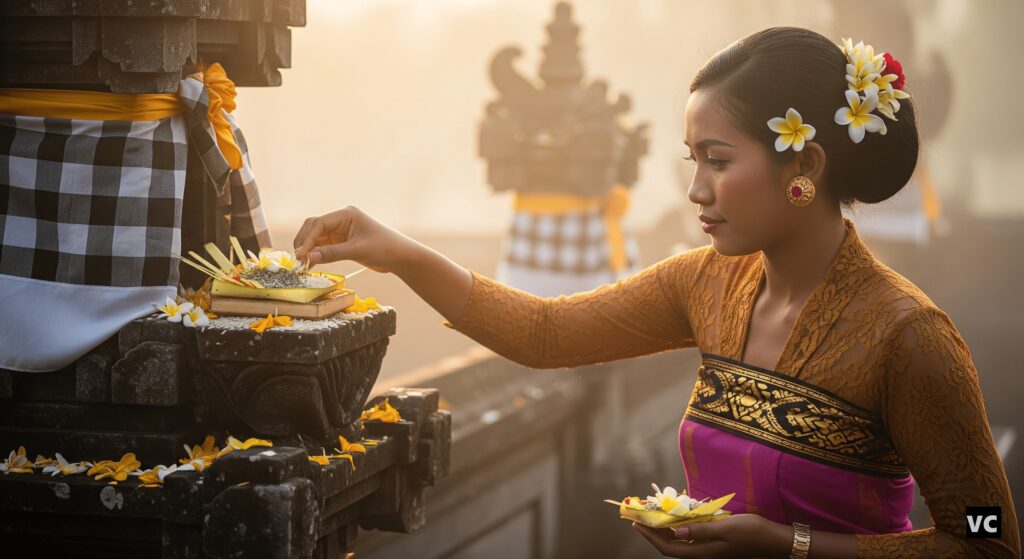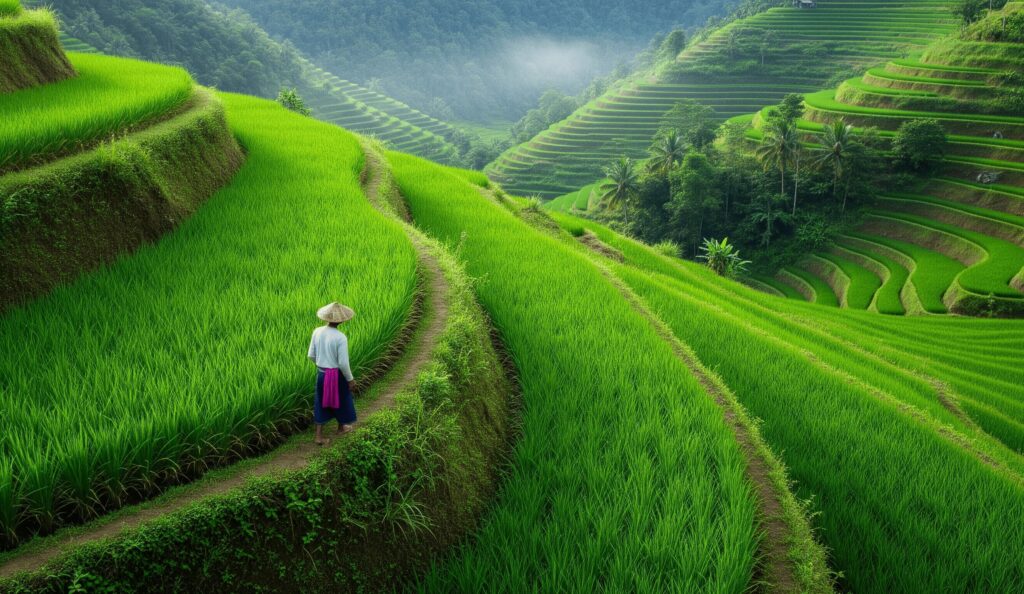“It wasn’t the temples that first moved me in Bali — it was watching an old woman scatter rice at sunrise.” That image, delicate grains glinting on the breeze, became the lens through which I came to understand the deep, windswept roots of rice in Asia. More than a mere crop, rice is woven through the spiritual, social, and emotional DNA of this vast continent. In every region I’ve wandered — from Indonesian terraces to Japanese tea houses and bustling Indian festivals — rice, in all its humble forms, bridges generations, faiths, and destinies.
Today, let’s travel together into the world of the cultural significance of rice in Asia. We’ll peek behind shimmering temple curtains, celebrate alongside villagers swaying to harvest drums, and probe the rituals that wrap this grain in layers of reverence and symbolism. My intent is to answer not only what rice is, but what it means — in rituals, milestones, awe-inspiring landscapes, and modern Asian identity.
A Grain That Built Civilizations
Asia’s landscapes and legends are stitched together by rice. As I crunched along dike paths in the Philippines or gazed over emerald paddy mosaics in rural Vietnam, it struck me: the physical world of Asia has been sculpted by a single grain. For thousands of years, rice didn’t just feed mouths — it built kingdoms, inspired poetry, and ordained both worship and work.
Rice, for much of Asia, is the sacred thread tying together faith, family, and sustenance. In this journey, we’ll explore:
- Ritual uses of rice in temples and daily prayers
- The meaning of rice in Asian traditions — especially at weddings, births, and farewells
- Rice symbolism in festivals and gratitude ceremonies
- How rice shapes physical landscapes and modern lives
Rice in Rituals: From Temples to Daily Prayers
My first morning in Bali, I noticed rice grains resting on shrines outside every home. In India’s southern towns, fresh rice is arranged in intricate kolam designs — auspicious mandalas drawn at thresholds as invitations to prosperity. In Chiang Mai temples, I watched saffron-robed monks receive bowls of sticky rice as dawn offerings. Even in Japan, simple rice cakes (mochi) placed on Shinto altars honor kami, the local gods.
Rice, in these sacred rituals, is a spiritual bridge — an offering that speaks of humility, gratitude, and hope for abundance. In Hindu temples, a pinch of raw rice (akshata) is blessed and gently placed atop devotees’ heads, signifying spiritual energy. In Buddhist monasteries, the rhythmic tapping of chopsticks on rice bowls marks daily chants — a moment of collective mindfulness.
Across Asia, the ritual uses of rice form tangible links between land, labor, and the divine. To offer rice is to acknowledge life’s interdependence — a lesson I felt with every grain I held in my palm.

Rice in Life Milestones: Weddings, Births, and Death
Rice is a witness to life’s most intimate crossings. I remember standing amidst a swirl of laughter at a Korean wedding as guests showered the bride and groom with rice, each grain a whispered wish for fertility and prosperity. In Indian weddings, rice is tossed on the departing couple to bless their union with abundance — a ritual whose sound echoes centuries of tradition.
After a birth in Vietnam, new mothers are gifted sticky rice cakes, believed to nourish body and spirit. During baby naming ceremonies in Thailand, families place rice in young children’s palms, hoping for blessings that will flow through their lives.
Even in death, rice carries souls onward. In Japanese funerals, a bowl of untouched rice is offered to ancestors — a sign of respect and remembrance. These rice rituals in Asia mark beginnings and endings, rooting every milestone in meaning far deeper than words.
In a village in northern Vietnam, I was handed a steaming bánh chưng, a sticky rice cake made just for new mothers. Its warmth felt like an embrace, a silent promise that rice would carry me through any journey.
Harvest Festivals and Gratitude Ceremonies
What are the major rice festivals in Asia? Every year, the cycle of planting and harvest spins out celebrations rich in color and communal joy.
- Pongal (Tamil Nadu, India): Days spent cooking new rice with milk, jaggery, and spices under the open sky — a tribute to the Sun god and the Earth’s generosity.
- Songkran (Thailand): Rice offerings are made to monks and ancestors, blending ancient gratitude into modern new year revelry.
- Onam (Kerala, India): Elaborate feasts (sadya) center around rice, served on banana leaves. Homes bloom with floral patterns, and the air smells of coconut and cardamom.
- Nuakhai (Eastern India): The first harvest is blessed, cooked, and shared with family and neighbors — a festival grounded in gratitude and unity.
- Galungan (Bali): Bamboo poles (penjor) sway outside homes, laden with rice cakes and offerings for ancestral spirits.
At these festivals, I’ve been swept along by the swirl of colors, the rhythm of drums, the scent of newly harvested rice. To witness rice fields waving in the wind during these times is to see centuries of tradition dancing at the edge of each stalk.
The Architecture of Rice: Terraces, Fields, and Labor
The story of rice is etched into Asia’s geography itself. In the Philippines, the emerald Ifugao rice terraces, cultivated for over 2,000 years, cling to mountain slopes in living testimony to human ingenuity and communal labor. Bali’s Subak irrigation system — a UNESCO heritage marvel — channels water through hand-dug canals, marrying spiritual ritual with sustainable farming. I’ve walked through Japanese paddy fields, where summer frogs chorus in symphony with farmers bent over water, each seedling placed with care.
Rice shapes not just customs but entire landscapes. Terraces mirror the patience of generations; fields reflect the wisdom of ecology and the unspoken covenant between humans and nature.

Modern-Day Connections: Rice in Asian Identity Today
Even as skyscrapers puncture Asia’s ancient horizons, rice holds fast to the region’s kitchen tables and collective heart. The farm-to-table movement is reviving heirloom rice varieties that had faded under the march of modernity. In Bangkok, I sat with chefs rediscovering the savory aroma of jasmine rice. In Japan, small cooperatives are nurturing rare strains once reserved for emperors.
Socially, rice is still at the core of hospitality — refusing a bowl of rice can be seen as declining someone’s warmth and care. Whether through urban rice festivals, organic paddy tours, or the resilience of traditional farmers, rice continues to evolve as both sustenance and symbol, speaking to the cultural significance of rice in Asia in every steaming bowl.
Reflections from a Traveler
In every bowl of steamed rice I was served from Myanmar to Kyoto, I saw generosity. Reverence. Home. Rice taught me that even the smallest things can be a vessel for memory, meaning, and movement. To eat rice in Asia is to touch a living story — one that will outlast us all.
I invite you to reflect: What grains shape your own story? How can something so seemingly simple gather up so much of who we are?
FAQs
Why Is Rice So Important in Asian Culture?
Rice is the staple food for more than half the Asian population. Beyond nutrition, it shoulders spiritual, social, and economic meaning — featuring in rituals, family gatherings, temple offerings, and celebrations of life’s major moments. Its cultivation and enjoyment symbolize harmony, community, and gratitude.
Which Festivals Celebrate Rice in Asia?
- Pongal (India)
- Songkran (Thailand)
- Onam (India)
- Nuakhai (India)
- Galungan (Bali)
These festivals blend rice with gratitude, music, dance, and spirituality, expressing deep thanks for nature’s bounty.
Is Rice Considered Sacred in Any Asian Traditions?
Yes — in Hinduism, Buddhism, Shinto, and animist traditions across Asia. Rice is routinely offered to deities, ancestors, and spirits; it’s considered a symbol of life, prosperity, and spiritual energy.
What Rituals Involve Rice in Asian Weddings?
Rice is tossed over newlyweds in India, Korea, Japan, and other countries as a blessing for prosperity and fertility. In some cultures, rice is included in wedding feasts or presented in ritualized offerings at ceremonies.


